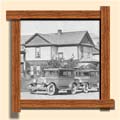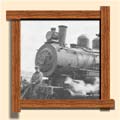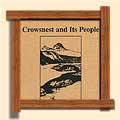 Heritage Community Foundation Presents
Heritage Community Foundation PresentsAlberta Online Encyclopedia
 |
|||
  |
|||
|
Home>> The Industry>> Mines>> Crowsnest Pass>> Hillcrest Mine |
|||
| Hillcrest Mine | |||
Continuing Mr. Hutchinson's Memoirs, 1919:
From 1919 to 1921 over 500 men were employed by Hillcrest Collieries and 250,000 tonnes of coal produced in a year. From Mr. Hutchinson's Memoirs: "At this time (1919) timber in the railway bridge across the river was replaced by a concrete and steel structure." "In 1920-21 a deal of sorts was made between Hillcrest Collieries and the Passburg Coal Co., who had opened a seam some years previously on the south side of the river. Among other things, a tipple and cleaning plant were built and a bridge and railroad to connect with the CPR line. This mine operated successfully until the demand for coal started to fall off." On a Sunday, September 19, 1926, at about 9 p.m. an explosion in the Hillcrest mine claimed the lives of two employees, Frank Lote and Fred Jones.
In the early 1920's crowds traveled to Bellevue, Blairmore and Coleman to root for their favorite hockey teams. Horse and sleigh was the conveyance of many fans, (cars on blocks for winter). Social and literary activities played their part in life in Hillcrest. Musical talent was not lacking there and honors were bestowed upon Hillcrest residents who competed in the Crowsnest Pass Musical Festivals and in those held provincially. By 1935 even the business market for commercial coal had dropped and a meeting of directors of the Collieries was called. Mr. Hutchinson was now General Manager of the Collieries and attended the meeting where a merger of Hillcrest Collieries and Mohawk at Maple Leaf was discussed. Soon after this Hillcrest Mohawk Collieries was formed. Profits were turned over to the new company to enable them to establish mechanical haulage and other improvements to help lessen production costs. Hillcrest Collieries went into liquidation in April, 1938.
The mine closed down December 2, 1939. The residents of
Hillcrest suffered a severe blow with the closing of the mine.
Some panicked and sold their houses at a loss but other miners
sought work in various industries in the Pass and have reaped a
benefit. Hillcrest has become a choice This article is extracted from Crowsnest and its People:
Millennium Edition (Coleman, Alberta, Crowsnest Pass Historical
Society, 2000) . The Heritage Community Foundation and
the Year of the Coal Miner Consortium would like to thank the
authors and the Crowsnest Pass Historical Society for permission
to reprint this material. |
|||
 |
|||
For more on coal mining in Western Canada, visit Peel’s Prairie Provinces.



